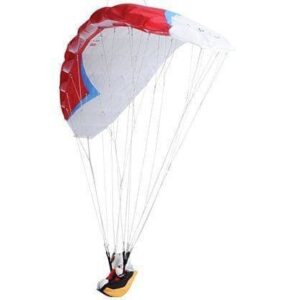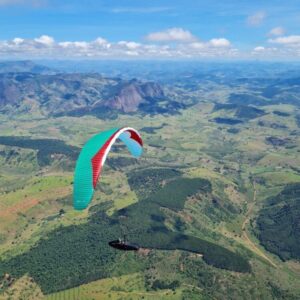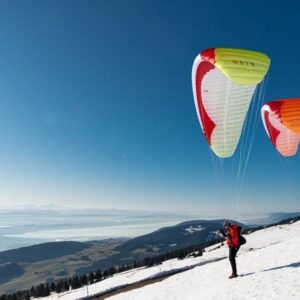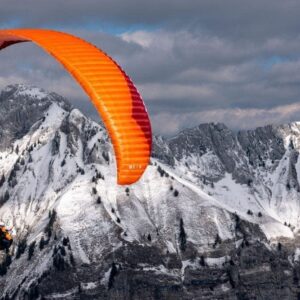Description
Fly gin paragliders Discover an the Gin Gliders Mini: Lightweight. Compact. Limitless.
Designed for Big Adventures in Small Packages
The Gin Gliders Mini is a revelation in ultralight flying. While it might carry the name “Mini,” this wing is anything but limited in capability. Engineered with the same care and high-performance DNA found in Gin’s full-size gliders, it delivers an exhilarating ride for hike & fly missions, soaring sessions, alpine launches, and even strong-wind coastal flights.yeti racing
This wing is tailored for pilots who crave simplicity, speed, and minimal weight without compromising control or safety. Whether you’re a seasoned hike & fly enthusiast or a bold explorer seeking new adventures, the Gin Gliders Mini redefines what’s possible with a compact glider.yeti racing
Precision-Crafted for Minimalism Without Sacrificing Performance
Compact Design, Maximum Enjoyment
What makes the Gin Gliders Mini stand out is its ability to compress the performance of a larger glider into a minimalist form factor. Meticulously trimmed and designed to perform optimally in high-wind conditions and thermal flying, it ensures intuitive control across varied terrains.yeti racing
Because of its exceptional glide ratio and pitch stability, the Mini becomes your go-to wing for spontaneous takeoffs and confident landings—even in unpredictable mountain air.
Who Is the Gin Gliders Mini For?
This model is ideally suited for:
-
Experienced pilots looking for a dynamic, responsive ultralight glider
-
Adventurers in need of a compact, dependable wing for alpine hike & fly
-
Coastal flyers requiring a stable, small-size wing in strong wind
-
Mountaineers wanting a lightweight backup for summit descents
-
Pilots seeking a wing for dynamic soaring or high-energy ground handling
Key Features of the Gin Gliders Mini
Highlight Specifications That Matter Most
-
✅ Ultra-Compact and Lightweight: Packs down to the size of a sleeping bag; easy to carry in a mountain pack
-
✅ Versatile Use Cases: Excellent for hike & fly, soaring, speed flying, or even high-wind coastal conditions
-
✅ Efficient Launch Behavior: Inflation is effortless, even in tight or steep takeoff zones
-
✅ Responsive Handling: Direct, agile inputs allow for exciting maneuvers while maintaining safety margins
-
✅ Reinforced Internal Structure: Despite its lightweight fabric, the build quality ensures long-term durability
-
✅ Wide Weight Range: Available in multiple sizes to accommodate different pilot weights and flight styles
-
✅ Certified Safety: Stability and predictability ensure peace of mind on aggressive descents or rocky launches
-
✅ Intelligent Risers: Color-coded lines and simplified riser configuration aid easy sorting and smooth pre-launch checks
Why Choose the Gin Gliders Mini?
paramotor wings for sale A Flight Companion That Goes Where You Go
Many wings are labeled “lightweight,” but few can genuinely match the balance of performance, reliability, and portability offered by the Gin Gliders Mini. From trailheads to mountain peaks, this glider demands little space in your pack but delivers maximum energy in the air.paramotor wings for sale
Moreover, it adapts to your environment effortlessly. Whether your mission is a challenging alpine descent, an impromptu thermal ride, or a seaside breeze session, the Mini handles all with smoothness and precision.paramotor wings for sale
How to Master the Gin Gliders Mini
Usage Guide for Confident Pilots
While the Gin Gliders Mini is intuitive to launch and land, it is best suited for intermediate to advanced pilots due to its dynamic nature and size. Familiarity with strong-wind takeoffs, pitch control, and dynamic soaring techniques will unlock the full potential of this glider.
Additionally, pairing the Mini with an ultralight harness like the Gin Yeti Convertible 2 ensures a perfectly balanced setup for demanding hike & fly escapades.
Safety First, Always
Reliable in Challenging Conditions
-
Always perform pre-flight inspections, especially in alpine terrain
-
Be mindful of wind strength: the smaller size translates to higher speed and more dynamic responses
-
Use a certified reserve system for high-altitude or strong-wind flying
-
Keep wing loading within the recommended range for stable behavior
Even though it’s a compact wing, the Gin Gliders Mini does not compromise on stability or passive safety. The profile remains composed under pressure, and recovery from collapses is fast and predictable—just what you need in technical environments.
Frequently Asked Questions
Is the Mini suitable for beginners?
No. Due to its high agility and loading requirements, the Gin Gliders Mini is designed for intermediate to advanced pilots.
What’s the difference between Mini and other lightweight wings?
The Mini has a higher wing loading and smaller surface area. It is more responsive, more agile, and performs better in high-wind or technical soaring conditions.
Can I use the Mini for thermal flying?
Yes! Despite its size, the Mini handles thermals well thanks to its agile handling and excellent pitch stability.yeti racing
What sizes are available?
Gin offers the Mini in several size options, typically ranging from 14m² to 20m², depending on the model year and pilot needs.yeti racing
Elevate Your Experience with the Gin Gliders Mini
This is more than a glider—it’s your license to soar on your own terms. It fits in your pack. It waits patiently at the summit. It springs to life the moment you run. Whether you’re launching into alpine air or gliding over coastal cliffs, the Gin Gliders Mini helps you write your next airborne adventure.paramotor wings for sale
paramotor wings for sale Light in weight, heavy on performance—take flight with the Mini today.
Fly GIN Paragliders: Elevate Every Flight
Firstly, If you’re serious about paragliding, there’s one name that stands out globally—Fly GIN Paragliders. Known for their innovation, reliability, and precision, GIN Gliders consistently push the boundaries of flight. Also, whether you’re a weekend explorer or a competition-driven XC pilot, GIN has designed wings to help you fly higher, farther, and smarter.Gin GTO 3
Built by Pilots, for Pilots
Furthermore, GIN Gliders was founded by legendary pilot Gin Seok Song, a world champion who continues to design every wing. Therefore, every paraglider reflects real-world insights and pilot-driven performance. Unlike mass-market alternatives, GIN wings are crafted with a deep understanding of what truly matters when you’re in the air.https://www.instagram.com/paragliding_explorer_wing_shop?igsh=bGg2dWxqNzQ1bzF4&utm_source=qr
Wings for Every Pilot Level of Fly GIN Paragliders
Whether you’re launching for the very first time or you’re perfecting your fifth SIV course, Fly GIN Paragliders offers a wing that fits your progression. For instance, beginners can count on the Bolero series for stability and easy handling. Meanwhile, intermediate pilots often choose the Explorer or Camino for long XC journeys. Additionally, acro enthusiasts will love the Gangster 2, made for wild dynamics and full control. No matter your path, GIN has a glider that meets your mission.aspect ratio of a wing






Innovation That Keeps You Ahead
What truly sets GIN apart is their obsession with innovation. Technologies like the Wave Leading Edge and Nitinol rod structure ensure better airflow, weight reduction, and higher collapse resistance. Moreover, GIN’s 2-liner EN-C wings bring competition-level performance into the hands of everyday pilots. Because of this, you get more performance without adding complexity.aspect ratio of a wing
Trusted by Professionals Worldwide
Top athletes, adventurers, and world champions continue to fly GIN paragliders for one simple reason—they deliver. From the Red Bull X-Alps to vol-biv expeditions in the Alps, GIN wings consistently perform in the world’s most demanding conditions. So, when the best trust GIN, you know you’re in good hands.
Conclusion: Make Every Flight Count
Ultimately, if you’re ready to take flight with gear that combines safety, performance, and soul, there’s no better choice. So, fly with confidence. Fly GIN Paragliders, and experience the skies the way they were meant to be explored.
Gin Gliders mini paraglider mobile! Designed for adults and kids, Gin’s new super compact, lightweight glider weighs in at only 0.20kg!
Stable and stress-free, the mini paraglider mobile features bleeding-edge technology–a spanwise metal spar makes it 100% deflation proof! Use it to brighten up your home, office, or nursery. Fantastic for enthralling your non-flying friends with the difference between a spiral dive and a spin…
DETAILS of Fly GIN Paragliders
- total height: 95cm
- projected span: 118cm
- flat span: 129cm
DOCUMENTS
Manual
🛡️ Gin Gliders Mini Safety Guide
Fly smart. Fly safe. Fly free.
Though the Gin Gliders Mini is designed with high stability and responsive handling, it’s a wing that thrives under experienced piloting. This guide helps you navigate flight prep, weather judgment, and risk management—all crucial to getting the most out of your flights without compromising safety.
✅ 1. Know Your Wing’s Purpose and Limitations
The Mini is not a general-purpose wing. Instead, it’s tailored for dynamic flying scenarios such as hike & fly, strong-wind soaring, or technical alpine descents.
-
Not designed for absolute beginners
-
Best flown within the recommended weight range
-
Requires familiarity with high loading behavior
-
Not suitable for mellow soaring or student training
⚠️ Flying outside the intended purpose increases the risk of instability or loss of control.
✅ 2. Pre-Flight Equipment Check
Before every flight, perform a thorough check of all equipment. The lighter construction of the Mini means small issues can have significant impacts.
Checklist:
-
🔍 Canopy: Inspect for rips, tears, or loose stitching
-
🔍 Lines: Confirm they are untangled, evenly tensioned, and free of knots
-
🔍 Risers & Maillons: Ensure all connections are tight and secure
-
🔍 Brakes: Check that brake handles are clear, lines move freely, and toggles are secure
-
🔍 Reserve Parachute: Confirm pin is secure and deployment handle accessible
-
🔍 Harness: Inspect buckles, straps, and carabiners for wear or damage
🧰 Don’t launch if anything feels off—double-check or walk back.
✅ 3. Understand Your Flight Conditions
Because of its high wing loading and small surface area, the Gin Gliders Mini behaves differently than full-size wings in certain conditions.
Ideal Flying Conditions:
-
💨 Wind Speed: 15–35 km/h depending on your wing size and weight
-
🌤️ Thermal Activity: Mornings and late afternoons tend to be smoother
-
🗻 Terrain: Wide, obstacle-free takeoffs preferred (though the Mini can handle tight launches with skill)
Avoid Flying If:
-
🌪️ Gusts exceed 40 km/h or are erratic
-
⛅ Clouds indicate strong thermals or instability
-
🌲 Terrain below is overly technical or lacks safe LZs
-
❌ Your body or mind is fatigued—stay grounded on off days
🌤️ When in doubt, don’t launch out.
✅ 4. Launching and Landing with Control
Though the Mini launches quickly, smaller gliders are less forgiving if mishandled.
Launch Tips:
-
Face directly into the wind
-
Inflate gently—avoid aggressive pulls on the A-risers
-
Check canopy symmetry during inflation
-
Confirm full overhead control before committing
Landing Tips:
-
Plan early—smaller wings glide faster and farther
-
Maintain slight brakes for pitch control
-
Flare decisively at the right moment
-
Use roll-out if terrain allows
🦶 Practice both forward and reverse launches regularly.
✅ 5. Respect the Wing Loading
The Mini is designed to be flown at high wing loading. This means more speed, more responsiveness—but also faster collapse reactions.
Important Considerations:
-
Faster reactions needed to control surges or pitch
-
Wing feels more dynamic in turbulence
-
Collapses can be quicker but recover fast with active input
-
Avoid flying near the upper weight limit if not confident in strong air
📈 More weight = more energy. Know what you’re handling.
✅ 6. Master Active Piloting
Active piloting isn’t optional on a wing like the Mini—it’s essential.
-
Keep constant brake input to manage pitch and roll
-
Learn to “read” air movements and adjust posture accordingly
-
Be ready to weight shift or brake to correct yaw
-
Stay relaxed but alert—tense arms create jerky inputs
🧠 Anticipate, don’t react. Feel the air, fly the wing.
✅ 7. Emergency Preparedness
Even with preparation, conditions can change. Have an escape plan and know how to use your reserve.
Your Emergency Plan Should Include:
-
📍 Safe landing zones along your flight path
-
🪂 Quick access and muscle memory for reserve deployment
-
📱 Fully charged communication device or GPS tracker
-
👥 Flight buddy or check-in protocol with someone on the ground
-
🛬 Knowledge of side-landings and descent techniques
🆘 You never regret being over-prepared—only under.
🧭 Use Guide for the Gin Gliders Mini
Unpack simplicity. Unleash performance. Understand every step.
Flying the Gin Gliders Mini is not just about taking off—it’s about using the wing with confidence, clarity, and capability. Whether you’re heading up a rugged trail for a hike & fly session, eyeing a coastal ridge for some dynamic soaring, or getting into speed flying, this guide equips you with everything you need to know to use the Mini safely and efficiently.
🧳 Step 1: Unpacking and Preparation
Before anything takes flight, you need to prepare with purpose.
-
Unfold the glider carefully—avoid dragging it across sharp terrain
-
Position the wing in a horseshoe layout, tips slightly forward
-
Untangle risers and lines methodically from harness to canopy
-
Lay risers symmetrically and confirm no line twists or snags
-
Attach your harness with karabiners locked and oriented correctly
-
Perform a full visual check of the wing fabric, seams, and lines
🧘 Patience in prep guarantees peace in flight.
🌄 Step 2: Choosing the Right Environment
The Gin Gliders Mini excels in specific environments—knowing where and when to fly is key.
Ideal Use Scenarios:
-
Hike & Fly missions where every gram counts
-
Strong-wind soaring on coastal cliffs or ridgelines
-
Quick-launch descents from alpine summits
-
Dynamic soaring sessions with tight landing zones
-
Ground handling and active pilot training in open fields
Avoid Using the Mini When:
-
Wind is too light (difficulty inflating due to reduced surface)
-
Air is highly turbulent beyond your active-piloting skill level
-
You’re unsure of your launch or landing options
-
You’re carrying gear that exceeds the recommended weight range
📍 Right place, right time—that’s when the Mini shines brightest.
🛫 Step 3: Launching Techniques
The Mini inflates and launches quickly. Timing and control make all the difference.
Forward Launch (Low Wind):
-
Face forward with slight tension on A-risers
-
Start walking, then jog forward steadily
-
Let the wing rise naturally, correcting with subtle brakes
-
Once fully overhead and balanced, commit to flight with confident steps
Reverse Launch (Moderate to Strong Wind):
-
Face the wing with lines crossed and brakes in hand
-
Pull A-risers gently until the wing inflates overhead
-
Control pitch with brakes and stabilize the glider
-
Turn smoothly to face forward, then launch decisively
🏃 Quick inflation means less room for hesitation—flow, don’t fight.
☁️ Step 4: Flying the Wing
In the air, the Gin Gliders Mini responds with agility and energy. Use this to your advantage by flying actively and attentively.
-
Maintain light brake pressure—just enough to feel air movement
-
Use weight shift in combination with brake inputs for efficient turns
-
Stay centered in lift; the Mini responds fast to both surges and drops
-
Monitor pitch and roll—adjust inputs gently to stay in control
-
Avoid aggressive maneuvering close to terrain unless well-practiced
🎯 Flying well isn’t flying fast—it’s flying aware.
🛬 Step 5: Planning and Executing Landings
The Mini’s high speed and glide ratio mean you’ll land farther and faster than with a standard-size wing.
Landing Tips:
-
Identify your landing zone early—keep it wide, clear, and open
-
Begin downwind, transition to base, and finish with a straight final approach
-
Apply mild brakes to regulate descent without stalling
-
Start your flare about one meter from the ground
-
Finish the flare smoothly while preparing to run or roll the landing
🛬 Precision comes from planning—not panicking.
🔁 Step 6: Packing and Maintenance
Caring for your wing ensures longer life and better performance.
-
Shake out dirt or sand before packing
-
Fold along panel lines without creasing plastic reinforcements
-
Use a concertina bag to preserve the leading edge if possible
-
Keep dry—never pack wet or damp
-
Store in a cool, dry space away from direct sunlight
-
Periodically check lines and risers for wear
🎒 How you pack today shapes how it flies tomorrow.
🔍 When to Use the Mini—and Why
Use the Gin Gliders Mini when you need:
-
✅ Speed and responsiveness on high-wind days
-
✅ Minimalist gear for long ascents or travel
-
✅ Compact setup that fits in a small alpine pack
-
✅ Energetic flight characteristics for advanced play
-
✅ A second wing that complements your full-size glider
💡 Pro Tips for Smarter Flying
-
✅ Fly early morning or late afternoon for smoother air
-
✅ Practice launches regularly to refine timing and technique
-
✅ Log each flight to track wind, weather, and personal notes
-
✅ Use lightweight harnesses like the Gin Yeti Convertible for a balanced setup
-
✅ Watch your glide—landings approach fast with a Mini
🧠 Final Words: Know Your Wing, Own Your Flight
The Gin Gliders Mini was built to push boundaries while staying light on your back. When used with awareness and intention, it becomes more than a glider—it becomes an extension of your will to explore. With every step up the mountain and every flight off its edge, you’re writing a new story of freedom.
✈️ Use it wisely. Fly it boldly. Trust it completely.
🚀 Fly With Confidence, Not Complacency
The Gin Gliders Mini delivers thrilling performance in a compact form—but it demands respect and skill. Use this safety guide as part of your flight ritual, and you’ll gain the confidence to explore further, climb higher, and touch down safely every time.
🪂 How to Fly the Gin Gliders Mini
Master dynamic ultralight flight—one step at a time.
Flying the Gin Gliders Mini is an adventure rooted in minimal gear and maximum thrill. While compact and agile, this wing demands precision, awareness, and skill. Whether you’re hiking to a peak, soaring coastal cliffs, or diving into thermals, knowing how to handle your Mini makes all the difference.
🏁 Step 1: Choose the Right Location and Conditions
Even the most experienced pilots respect the wind. Before unrolling your glider, assess the terrain and air.
-
✅ Look for smooth takeoff zones, free from obstacles and turbulence
-
✅ Face directly into the wind; side gusts can destabilize the launch
-
✅ Ideal winds: 15–30 km/h, depending on wing size and your weight
-
✅ Check for rotor zones, power lines, trees, or water hazards
-
✅ If in doubt, wait it out—weather can shift in moments
🌬️ The Mini is fast and agile—strong-wind launches require excellent control.
🧳 Step 2: Pre-Flight Setup
Small wings still require full preparation. Taking shortcuts can cost you altitude—or safety.
-
Unpack the glider carefully, allowing it to unfold naturally
-
Untangle and align the lines from risers to canopy
-
Double-check riser orientation (A-risers up front)
-
Check harness buckles, leg loops, and reserve handle
-
Inspect brake toggles, ensuring they’re clear and reachable
-
Verify wind direction and stand centered behind the wing
🛠️ Prepping slowly is faster than fixing mistakes mid-air.
🛫 Step 3: Master the Takeoff
Launching the Gin Gliders Mini is thrilling—but it happens fast. With smaller surface area and higher wing loading, the wing rises quicker and demands cleaner input.
For Forward Launch (No Wind or Light Wind):
-
Hold A-risers with slight tension, arms relaxed
-
Begin walking, then jogging forward with steady speed
-
As the canopy rises, glance overhead to check symmetry
-
Apply gentle brakes to stabilize the wing
-
Once fully overhead and flying straight, accelerate into takeoff
For Reverse Launch (Stronger Winds or Technical Terrain):
-
Face the glider with lines crossed
-
Pull the A-risers to inflate
-
As the wing lifts overhead, quickly turn and align yourself
-
Stabilize using weight shift and light brake input
-
Run decisively into the wind to lift off
🏃♂️ Commit to the launch—hesitation can stall the wing.
☁️ Step 4: Control in Flight
Once airborne, the Mini reveals its character: agile, energetic, and incredibly responsive.
In Calm Air:
-
Maintain relaxed posture with light brake tension
-
Let the wing find its own pitch, intervening only when necessary
-
Shift your weight for smooth turns and coordinated banking
In Thermals or Turbulence:
-
Fly actively—brake pressure tells you everything about lift and sink
-
Respond to surges with brake input to dampen pitch
-
Use weight shift for direction changes; it’s smoother than hard pulling
-
Stay centered in lift by visual cues and subtle brake balance
🧭 Be one with the air—feel, adapt, and flow with conditions.
🧭 Step 5: Navigating and Maneuvering
The Gin Gliders Mini excels in quick turns, wingovers, and dynamic flying. However, every move should be intentional and informed.
-
Use gradual brake pressure to initiate turns
-
Combine weight shift with brake pull for smoother carving
-
Avoid aggressive inputs near the ground or during thermals
-
Practice S-turns, pitch control, and roll coordination in open airspace
-
Don’t spiral too low—the Mini loses altitude quickly when turning sharply
🎯 Smooth equals safe—master finesse before showing off.
🪂 Step 6: Approach and Landing
Landing a Mini requires planning. Due to higher speed and glide ratio, the approach window can be longer than expected.
-
Identify your LZ from the air—clear, flat, and free of obstructions
-
Start downwind, then turn base, and finish with a final approach
-
Keep hands at mid-brake to manage descent rate
-
Begin a gentle flare 1–2 meters above ground
-
Finish with a strong, symmetrical flare at foot level
-
Let your legs absorb impact and run out your landing if necessary
🛬 Early decisions make graceful landings.
✍️ Quick Tips to Master the Gin Gliders Mini
The Essentials You Should Always Remember
-
✅ Trim Smart: Fly within recommended weight range for your size
-
✅ Stay Active: Keep your hands on the brakes and your mind in the air
-
✅ Observe Weather: The Mini is sensitive to turbulence and gusts
-
✅ Pack It Clean: Keep sand, snow, and debris off the fabric and lines
-
✅ Train Regularly: Ground handling boosts skill and confidence
-
✅ Fly With a Buddy: Or check in before and after every flight
-
✅ Respect the Wing: It’s powerful, light, and fast—treat it like a sports car, not a cruiser
🧠 Final Thought: Every Flight is a Lesson
Flying the Gin Gliders Mini combines freedom with responsibility. Although small and simple in appearance, it’s a highly tuned tool for passionate, skilled pilots. Mastering it doesn’t happen overnight—but each flight gets you closer to full control and total enjoyment.
✈️ With the Mini under your feet and the sky above, you’re never far from your next adventure.
Related products
-

Gin Boomerang 12 COMPETITION CCC Wing
£4,200.00Select options This product has multiple variants. The options may be chosen on the product pageAdd to WishlistAdd to Wishlist -

Gin Yeti 5 EASY / HIKE ‘N FL EN A
£3,000.00Select options This product has multiple variants. The options may be chosen on the product pageAdd to WishlistAdd to Wishlist -

Gin Bonanza 3 PURE XC EN C Wing
£3,800.00Select options This product has multiple variants. The options may be chosen on the product pageAdd to WishlistAdd to Wishlist -

Gin Yeti tandem 3
£3,000.00Select options This product has multiple variants. The options may be chosen on the product pageAdd to WishlistAdd to Wishlist

Reviews
There are no reviews yet.